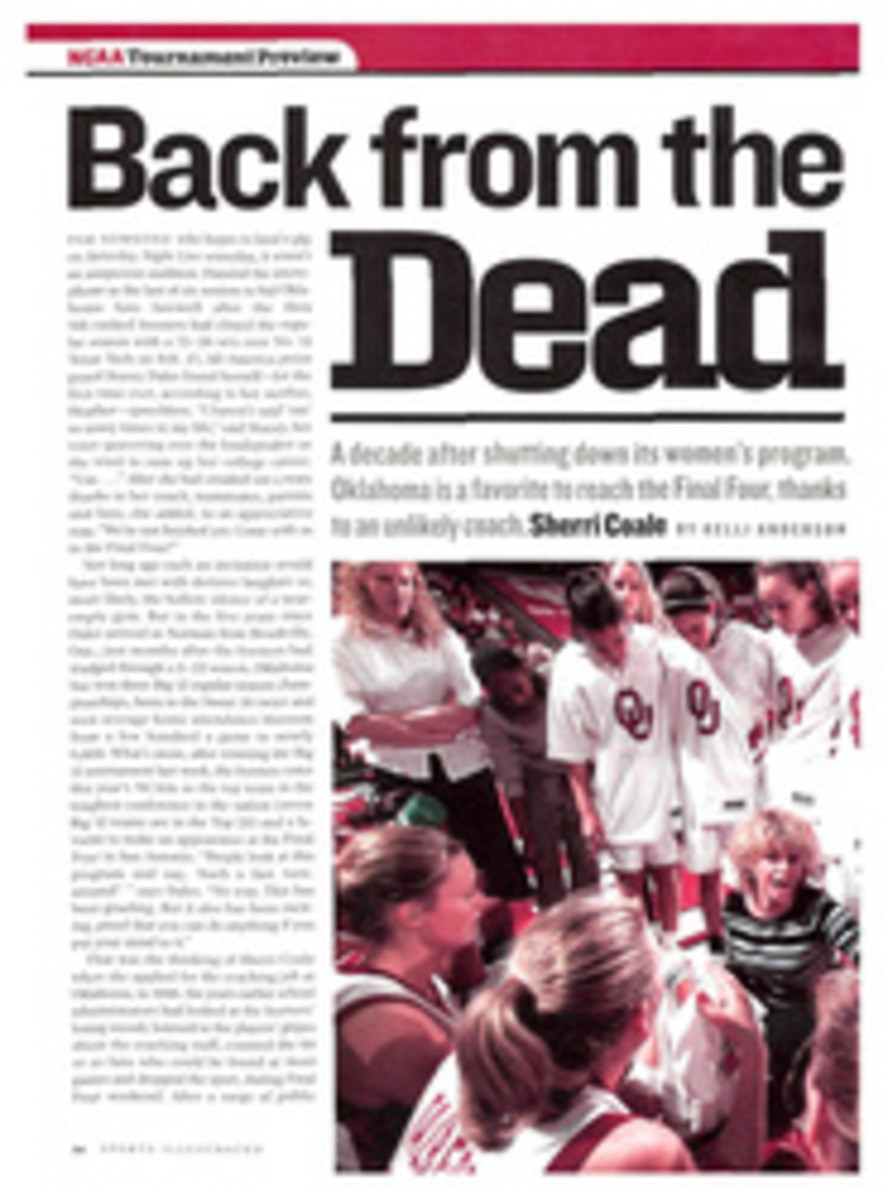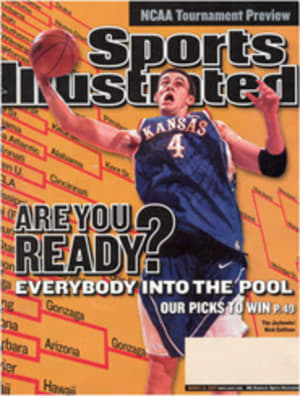
Survivor What began as a snowmobile joyride in the Wyoming wilderness became a 17-hour ordeal in which Olympian Rulon Gardner grappled for life and limb
Rulon Gardner had a terrific day planned for Feb. 14. Then
again, most of Gardner's days have been pretty terrific since
the cherubic farm boy from Afton, Wyo., shocked the world by
beating the legendary Alexander Karelin of Russia to win the
gold medal in the heavyweight class of Greco-Roman wrestling at
the 2000 Olympics. Still, this Valentine's Day loomed as
especially nice. Gardner and two friends were going snowmobiling
in the Bridger-Teton National Forest, east of Afton. The plan
was to ride up Wagner Mountain, then take in the glorious vistas
overlooking the Star Valley. That night Gardner and five friends
had dinner reservations at the stylish Red Oak Grill in Jackson.
The afternoon was perfect, clear and cloudless and, at about
25[degrees], plenty warm for a few hours of winter fun. The
night, however, would not be perfect. It would be the longest of
the 30-year-old Gardner's life--and very nearly the last.
Dan Schwab lives on a golf course in Afton, across from the
250-acre dairy farm where Gardner and his eight siblings grew
up. An avid and experienced snowmobiler, Schwab, 36, invited
Gardner and another friend, Trent Simkins, 20, to make the
seven-mile trip to Cottonwood Lake, where they would ride into
the national forest. The group left just after 1 p.m. Schwab
knew the land intimately but, as always, carried a survival pack
containing matches, a flammable gel used to start fires and a
small shovel to dig an emergency shelter.
At about 3:30, Schwab--with the survival pack still in his
snowmobile--said goodbye to his companions and headed home; his
daughter, Chelsi, had a basketball game that night. He asked
Gardner to call him by cell phone at around 4:15 to make sure
Schwab got back safely, and Gardner did, from high on Wagner
Mountain. "He told me he was on top of the world," Schwab said.
By then Gardner was riding solo. Simkins, a less aggressive
snowmobiler, didn't feel comfortable with the steepness of the
terrain Gardner wanted to explore. The two planned to motor
alone for a bit before meeting up again. Gardner later spotted
what he thought were Simkins's tracks going down toward a gully,
a narrow sliver between the mountains that was actually the
trickling start of the Salt River. He zipped down, only to
discover that the tracks he was following were his own, made
during one of his earlier loops. "I thought it would be no big
deal to get back up the mountain," Gardner said.
Once Gardner was all the way in the gully, however, he had
little choice but to follow its course. The space was too narrow
to turn around the 500-pound Polaris and the sides too steep to
climb, especially without room to build up speed. The crevice
would be his home for most of the next 17 hours. He followed its
winding trail south first, then east, and finally west. Twice he
made it out of the ravine, carving a crazy path through trees
and down precipitous inclines that even the valley's most
experienced snowmobilers wouldn't attempt to navigate--it was
far too dangerous--when they tried to follow his tracks later
that night. Always, though, Gardner returned to the widening
riverbed, knowing that eventually it would open into the Star
Valley and familiar terrain.
Gardner was wearing five thin layers--an undershirt, a
snowmobile bib, a T-shirt, a sweatshirt and a fleece
pullover--in addition to a ski mask and two pairs of gloves.
That was not enough to keep him warm after nightfall, which came
about 6 p.m. More worrisome, Gardner got wet a little after
four. Twice his snowmobile lodged in water holes, sinking to his
hips; once he ripped out a 10-foot trunk of a decaying tree to
extricate the machine. Farther down the river he rode in and out
of the water three more times, the last at around 7:15.
The final time he went into the icy river, he submerged his
entire back. This time he was too exhausted to free his
snowmobile. Eventually he trudged toward some trees 50 yards
distant, brushing away snow to make a small shelter while the
branches blocked some of the wind. The night was exceptionally
clear--and exceptionally cold. Temperatures would drop to
-25[degrees].
Gardner began a grim struggle to survive. Knowing that if he
fell into a deep sleep he would likely die, he propped himself
against a tree at an odd angle so that if he dozed, he would
start awake. He laboriously removed his left boot to take off
his drenched sock, but his hands became too cold to do the same
to his right. He pulled the sleeves of his sweatshirt over his
hands and blew on them constantly. After getting his left boot
back on, he stood, then stamped his feet, then sat, then stood,
over and over. He was convulsed by a full-body shiver but wisely
realized that it was his body's defense mechanism, so he didn't
try to stop shaking.
The hours crept by. Gardner nodded into fitful sleep, dreaming
he was in a warm shower, only to wake to his frozen reality.
Finally he extricated his cell phone to check the time--he had
no reception in the ravine to make a call--and was stunned to
discover it was only 12:30. For the first time he was truly
frightened.
Around 2 a.m. Gardner heard the snowmobiles of the Star Valley
search and rescue team. They were just 200 yards away, but when
he tried to yell, he found he didn't have the strength. He
whistled instead, the sound trailing helplessly away. At 6:30
Gardner struggled down to the river and took his first drink in
nearly 24 hours. Then, exhausted and a bit delirious, he slumped
against a rock. "I said, I need to go," he says, "but I just
couldn't. About 10 minutes later a plane went over me. I was
like, Ohhhh, plane. I was half in and half out."
While lying on that rock shortly before seven, Gardner spotted
the plane. Flying overhead was Mark Heiner, a pilot helping the
29-person rescue effort. Heiner tipped his wings to acknowledge
Gardner and tossed a coat, which the disoriented Gardner spent
nearly 20 minutes trying but failing to locate. It would be two
hours until Gardner would crawl on all fours into a rescue
helicopter dispatched from Idaho Falls--one of three choppers
sent to rescue him that morning. His body temperature was
80[degrees], a level typically marked by falling into a coma.
Gardner spent nearly two weeks in the Eastern Idaho Regional
Medical Center before he was discharged on Feb. 28. Doctors
needed a cast saw to remove the frozen size-13 boot from
Gardner's right foot. The tips of his toes were severely
frostbitten. He may yet lose his right middle toe, and he will
likely need skin grafts on several of his toes. But he's
optimistic that he will wrestle again--and he's alive. After 17
hours alone in subzero wilderness, that is truly something. "I
told myself that my life isn't finished," Gardner says. "I still
have a lot of dreams. I want to make the Olympic team again. I
want to grow old."
COLOR PHOTO: PHOTOGRAPHS BY JOEY TERRILL Lost and found When the rescue team reached the accident site, Gardner's feet were frozen and he was half-delirious from exposure.
COLOR PHOTO: COURTESY OF RULON GARDNER (INSET) [See caption above]
COLOR PHOTO: PHOTOGRAPHS BY JOEY TERRILL Career saver His frostbitten toes require skin grafts, but Gardner may yet have the chance to repeat his 2000 Olympic heroics.
COLOR PHOTO: DAVID GUTTENFELDER [See caption above]
When Gardner crawled into a rescue chopper, his body temperature
was 80[degrees], a level marked by falling into a coma.

